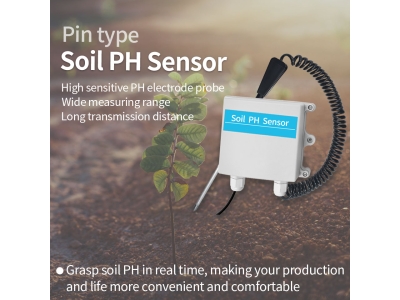Introduction In recent years, the agricultural industry has witnessed a revolutionary transformation driven by technological advancements. One of the most significant developments in this domain is the emergence of soil sensor technology, which has revolutionized crop management practices. Soil sensors have enabled farmers to gather real-time data about soil conditions, leading to more informed decision-making and improved crop yields. This article explores the advancements in soil sensor technology and its profound impact on modern agriculture.

The Evolution of Soil Sensor Technology The use of sensors to monitor soil conditions is not a new concept. Traditional soil testing methods involved collecting soil samples and sending them to laboratories for analysis. While these methods provided valuable insights, they were time-consuming and often did not capture real-time variations in soil conditions. The advent of soil sensor technology has transformed this landscape by enabling continuous, on-site monitoring of key soil parameters.
Early soil sensors were primarily designed to measure basic parameters such as soil moisture and temperature. These sensors utilized simple probes to collect data, which was then transmitted to a central monitoring system. Over time, advancements in sensor technology have led to the development of more sophisticated devices capable of measuring a wide range of soil properties, including nutrient levels, salinity, and pH. Furthermore, modern soil sensors are equipped with wireless connectivity, allowing farmers to access real-time data remotely via mobile devices or computers.
The Impact on Crop Management The integration of soil sensor technology into crop management practices has had a profound impact on the way farmers approach cultivation. By continuously monitoring soil conditions, farmers can make data-driven decisions regarding irrigation, fertilization, and other agronomic practices. This targeted approach not only optimizes resource utilization but also minimizes environmental impact by reducing the overuse of water and agrochemicals.
One of the key benefits of soil sensor technology is its ability to facilitate precision agriculture. By analyzing real-time data from soil sensors, farmers can create detailed spatial maps of their fields, identifying areas with specific soil deficiencies or excesses. This enables them to tailor their management strategies at a micro-level, applying inputs only where they are needed. As a result, crop yields are maximized, input costs are minimized, and overall productivity is optimized.
Furthermore, soil sensor technology plays a crucial role in sustainable agriculture practices. By promoting efficient resource management, it contributes to the conservation of water and soil quality. Additionally, by reducing the reliance on chemical inputs, soil sensors support the development of environmentally friendly farming practices, aligning with the growing demand for sustainable food production.
Challenges and Future Directions While soil sensor technology has brought about significant advancements in crop management, several challenges remain. One of the primary obstacles is the cost associated with deploying soil sensor networks across large agricultural areas. While the prices of soil sensors have decreased in recent years, the initial investment required for widespread adoption can still be a barrier for small-scale farmers. Addressing this challenge will be crucial in ensuring equitable access to this transformative technology.Another challenge is the interpretation of the vast amount of data generated by soil sensors. As the number of sensors deployed in the field increases, farmers may face difficulties in analyzing and utilizing the data effectively. There is a growing need for user-friendly data management and analysis tools that can help farmers derive actionable insights from soil sensor data without requiring advanced technical expertise.
Looking ahead, the future of soil sensor technology in crop management is promising. Continued advancements in sensor design, data analytics, and connectivity are expected to further enhance the capabilities of soil sensors. For example, the integration of artificial intelligence and machine learning algorithms can enable soil sensors to provide predictive insights, helping farmers anticipate soil conditions and optimize their management practices proactively.
Moreover, the development of low-cost, scalable sensor solutions will be crucial in expanding the adoption of soil sensor technology among smallholder farmers in developing regions. By making these technologies more accessible, the agricultural industry can promote inclusive growth and support sustainable development goals.
Conclusion The advancements in soil sensor technology have undoubtedly revolutionized crop management practices, offering a pathway to more sustainable, efficient, and productive agriculture. By providing real-time insights into soil conditions and enabling precision management strategies, soil sensors have become indispensable tools for modern farmers. As the technology continues to evolve, it holds the potential to drive further innovation in agriculture, ultimately contributing to global food security and environmental sustainability.
In conclusion, soil sensor technology represents a pivotal advancement in the agricultural industry, empowering farmers to make informed decisions and optimize their crop management practices. As we look toward the future, the continued development and adoption of soil sensor technology will play a vital role in shaping the next generation of agriculture, ensuring a more resilient and productive food system for generations to come.






